Widgetized Section
Go to Admin » Appearance » Widgets » and move Gabfire Widget: Social into that MastheadOverlay zone
Countdown to IRC: Randy Lee on Competition Revolvers
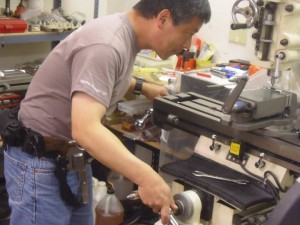 Talk to Randy Lee and you quickly get the impression that he’s not your average gunsmith.
Talk to Randy Lee and you quickly get the impression that he’s not your average gunsmith.
His work alone sets him apart, and with nearly 80% of the competitors at this year’s International Revolver Championships either running one of his Apex Tactical custom-built guns or utilizing Apex parts, his work is far from average.
But beyond the silky smooth perfection of a 3.5 pound double-action trigger that routinely drops the jaws of those expecting the standard 10 to 12 pound stock trigger, you come to realize that Lee isn’t a gunsmith at all but a highly skilled and very talented engineer who just happens to work with guns.
A graduate of California Polytechnic State University, or Cal Poly, Lee actually studied electronic engineering.
“I am an electronic engineer by trade, but my expertise in gunsmithing is because at Cal Ploy we had to cross-train in mechanical and material engineering. We learned by doing. It was very hands-on so it’s that engineering mindset that I draw from in my work with firearms,” explained Lee.
Lee’s introduction to gunsmithing came during his days in engineering school when friends would ask for help with their guns. “I started while at Cal Poly doing it for friends going into the police academy and sheriff’s department, and then as a form of extra money. It just sorta spiraled out of control from there,” jokes Lee.
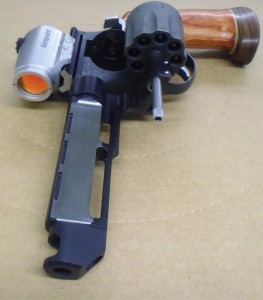 In late 2000, early 2001 Lee opened the doors of Apex Tactical, a small gunsmithing business specializing in revolvers. Today, Lee is one of the few actual engineers in the gunsmithing field and his business has grown to become the preeminent wheelgun house in the United States with a reputation that reaches overseas.
In late 2000, early 2001 Lee opened the doors of Apex Tactical, a small gunsmithing business specializing in revolvers. Today, Lee is one of the few actual engineers in the gunsmithing field and his business has grown to become the preeminent wheelgun house in the United States with a reputation that reaches overseas.
“We have most of the top revolver shooters sending their guns to us, and because Smith & Wesson is a global brand whose revolvers are carried throughout the world we are often contacted by international shooters. We even had the French IPSC (International Practical Shooting Confederation) revolver team ask us for help with their guns,” said Lee.
While federal firearms laws and State Department regulation make it difficult for Lee to take on international customers, his U.S. clientele keep him more than busy. This is particularly true for competition shooters who can see dramatic improvement in performance from a custom-tuned revolver.
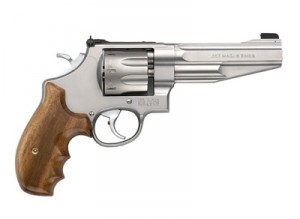 Apex can transform a stock Smith & Wesson Model 627 .357 Mag./.38 Spcl. 8-shot revolver with an MSRP of $1,414, and a street price of around $1,050, into a $4,000 Open division competition revolver built to win titles.
Apex can transform a stock Smith & Wesson Model 627 .357 Mag./.38 Spcl. 8-shot revolver with an MSRP of $1,414, and a street price of around $1,050, into a $4,000 Open division competition revolver built to win titles.
Lee’s custom work focuses on three main areas; accuracy, recoil reduction and action work.
In ICORE competition – the International Confederation of Revolver Enthusiasts governs most revolver-only matches including the IRC – accuracy is at a premium, especially when 50-yard targets come into play and a shooter is looking to put six rounds into a 3.5 inch x-ring in the shortest time possible.
“Shooters need a gun that is capable of hitting that x-ring six times in under 9 seconds on demand, so we replace the factory barrel with a custom barrel or a barrel blank that we finish in his house,” explained Lee.
To reduce recoil Lee prefers to port the barrel rather than opt for a compensator, which he feels can hinder accuracy at the low ammunition pressures competitors use in their reloaded ammunition.
“My preference is to port a barrel for recoil reduction. The lighter loads between 700fps and 800fps won’t deliver the mach cone, or shockwave you’d usually find in a compensated semi-auto pistol and can lead to a build up in the compensator that impacts the bullet’s performance,” observed Lee.
But it’s Lee’s groundbreaking trigger work that many see as the secret to his gunsmithing success. For the longest time a 5 pound trigger was the lightest that a gunsmith could deliver in an action job and still have reliability.
Lee was the first to break the 5 pound trigger pull barrier. He was also one o f the originators of the use of the lighter titanium cylinder in a stainless revolver frame.
“We broke the 5 pound barrier with trigger pull weights in the fours and now the threes. Beyond lightening the trigger pull we make it smoother by reworking the internal spring set up, hammer geometry and firing pin performance. We aim for a very linear pull that’s consistent all the way through the trigger stroke and avoids stacking that comes from drag resistance and spring compression balance,” explained Lee.
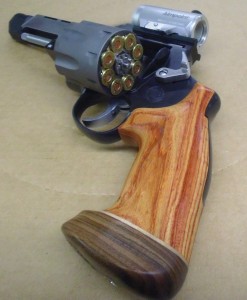 How much performance improvement does one get from a $4,000 custom-built revolver?
How much performance improvement does one get from a $4,000 custom-built revolver?
Lee estimates that the average shooter will see a 20% gain over the same model out-of-the-box, stock gun, while top level shooters can see upwards of a 60% improvement, making a trip to Apex Tactical well worth the investment.
“What people notice most about our work is that they are no longer fighting the gun for speed and accuracy. That has a huge impact on the competitive shooter both physically and mentally,” said Lee, who is himself a competition shooter and firearms instructor. “Just like in other sports, shooters are looking for any advantage that can help them reach the first pace.”
When the final shots are fired at the 19th Annual Smith & Wesson International Revolver Championships this weekend it’s a safe bet that Apex Tactical will see more than one of its guns in the winner’s circle, and with any luck Apex Tactical shooting team members Lisa Farrell, Scott Folk or Randy Lee himself will be there too.
One Response to Countdown to IRC: Randy Lee on Competition Revolvers
You must be logged in to post a comment Login

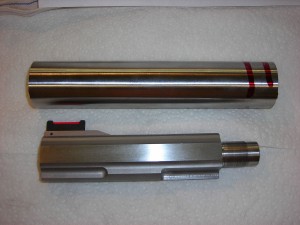


 MidwayUSA
MidwayUSA Ruger Firearms
Ruger Firearms SCCY Firearms
SCCY Firearms Streamlight
Streamlight Action Targets
Action Targets Gunsite Academy
Gunsite Academy
Pingback: Tweets that mention Countdown to IRC: Randy Lee on Competition Revolvers: Talk to Randy Lee and you quickly get the impression that he... -- Topsy.com